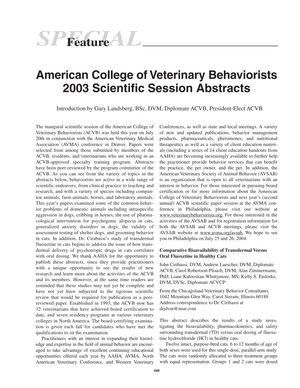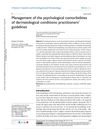American College of Veterinary Behaviorists 2003 Scientific Session Abstracts

TLDR Transdermal fluoxetine is less effective in cats, clomipramine may help with feline alopecia, younger dogs often start fights, dietary changes can reduce cribbing in horses, negative aggression tests in shelter dogs predict good behavior, many older cats show cognitive issues, and fluoxetine or paroxetine can improve canine anxiety.
The 2003 scientific session of the American College of Veterinary Behaviorists presented various studies on animal behavior. Key findings included that transdermal fluoxetine in cats had only 10% bioavailability compared to oral administration, and clomipramine showed potential efficacy for feline psychogenic alopecia. Research on sibling rivalry in dogs indicated younger dogs often initiated fights, and frequent aggression predicted poor treatment outcomes. Dietary changes were found to reduce cribbing in horses. Behavioral assessments in shelter dogs revealed that negative results for possessive aggression predicted post-adoption behavior. Additionally, 35% of cats over 11 years old showed signs of cognitive dysfunction, with older cats displaying more symptoms, and similarities in amyloid plaque formation were noted between aged cat and human brains. Treatment of canine generalized anxiety disorder with fluoxetine or paroxetine showed improvement in 67% and 50% of dogs, respectively, though side effects were observed.



